#rapid avian species
Note
*smacks your door open like Shrek* FACTS ABOUT VULTURES, BRO?
A… VULTURE is a raptor
across the world adapted
to feed on diverse creatures once dead.
They can snack on carrion
pausing from aviation
to shine as pinnacle symbols of dread.
Well, these birds barf acid
and they digest rapid,
Circling a carcass even 'fore it goes flaccid.
But some will kill lambs just to eat their bones,
they scoop 'em up live and they drop 'em on stones.
Some have bald heads, some fly in fleets,
Some cool off by pissing on their feet.
Their stomach acid kills most disease,
As digitigrades they have funky knees.
Condor- That's a Vulture,
They're endangered, must breed.
Bearded- That's a Vulture,
They digest bones to feed.
There's species in new world and old,
They have feathers to protect from the cold.
In some legends, they can play the grim reaper.
Then in others, they can be your soul's keeper.
To Aztecs they meant rejuvenation,
In the Ramayana one had earned much veneration.
Some can use tools like rocks to break shells,
some can hunt well only using just smell,
some will dye their feathers with red blood,
without them most ecologies would go thud.
Turkey- That's a Vulture,
Turkey Vultures, I mean.
Buzzard- That's a Vulture,
They're endemic to Crete.
A feeding group is called a "wake,"
then when they're in flight, a "kettle" they make.
(Musical interlude and wet Vulture eating sounds sample)
Hooded- That's a Vulture,
They can nest in palm trees.
Griffon- That's a Vulture,
They're big on Halloween.
Dress as vultures to impress your friends,
They'll all miss the bird jokes when holidays end…
Some vultures lack notes-
There's no organ in their throats
that can make a chirp or caw or a squeak.
But, if they were to quote,
they would probly rather eat a goat,
that was already minced for their beak.
So, that's a vulture,
that's their avian culture.
Immortalized in paintings and immortalized in sculpture.
They're pretty cool birds and they sure look neat,
especially when dripping with rotting meat.
So help conserve and leave them be,
and adore them if they're in a tree.
Accipitridae or Cathartidae,
Enjoy them all and look at them fly!
White-Rump, that's a Vulture,
it is named for its butt.
Palm-nut, that's a Vulture,
it can feed on mollusks.
So that's all about this fine bird.
Go and fact check everything that you've just heard.
Yes, that's all about this great bird.
No go write about them, you absolute nerd.
#vulture#vultures#all-star#smash mouth#slight unreality#please anyone send me a message if you record this
378 notes
·
View notes
Text
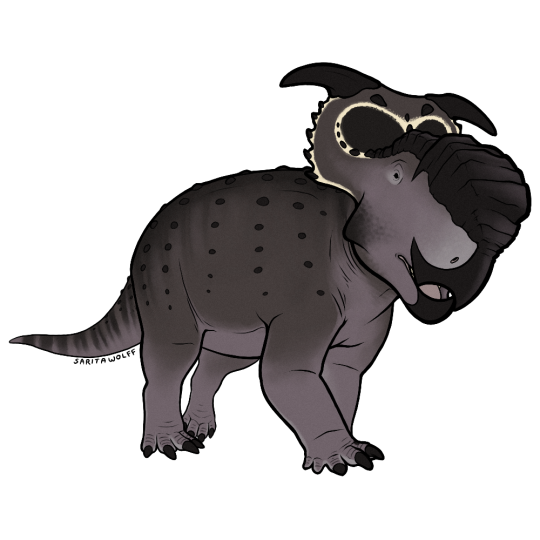
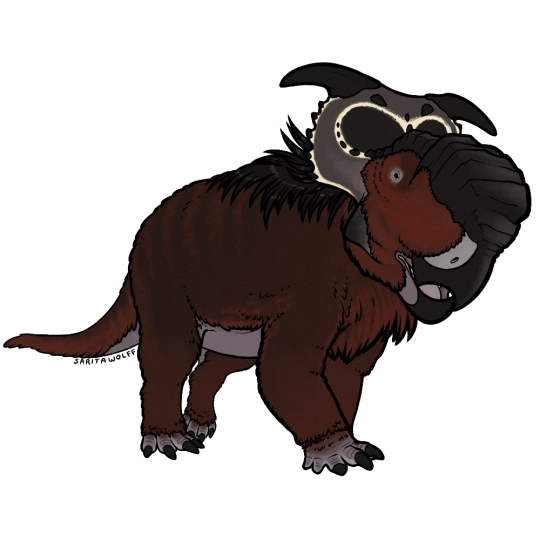
A Patreon request for rome.and.stuff (Instagram) - Pachyrhinosaurus perotorum… that I went a bit overboard with lol. I’ve been waiting for an excuse to draw my favorite ceratopsian, and to digitally adapt my old Pachy marker drawing design.
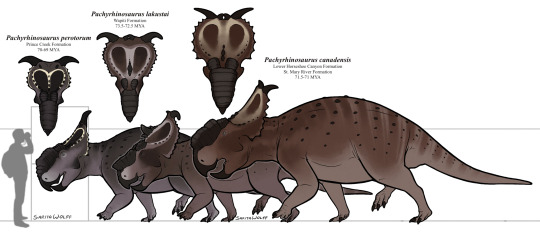
So! Pachyrhinosaurus! As seen above, there were three known species of Pachyrhinosaurus, living in different locations and eras in Late Cretaceous North America.
The oldest, P. lakustai, was native to the Wapiti Formation of Alberta and British Columbia, Canada. It’s known for the extra spikes it has at the center of its frill.
The slightly younger P. canadensis was native to the lower Horseshoe Canyon Formation and the St. Mary River Formation of Alberta and northwestern Montana. It was the largest of the three.
The youngest, P. perotorum, was native to the Prince Creek Formation of Alaska. As this ceratopsid seemingly stayed put during the long, dark, cold Alaskan Winters, it likely had adaptations for keeping warm.

The depiction of a “woolly” Pachyrhinosaurus was first popularized by Mark Witton as a speculative work, but the trope has prevailed. While many paleontologists find a heavy feather covering on a centrosaurine to be highly unlikely, and maintain that the animal’s size and homeothermy would have kept it warm enough, we still have no skin impressions to suggest that P. perotorum was fully scaly. So a feather coating is not completely out of the question (though it is unlikely). Still, I love the look of a woolly Pachyrhinosaurus and how it challenges our previous conceptions of non-avian dinosaurs. Stranger things exist in nature. I had to include a “woolly” option, especially since I already use the guy as my avatar on my paleo Instagram account, SaritaPaleo.
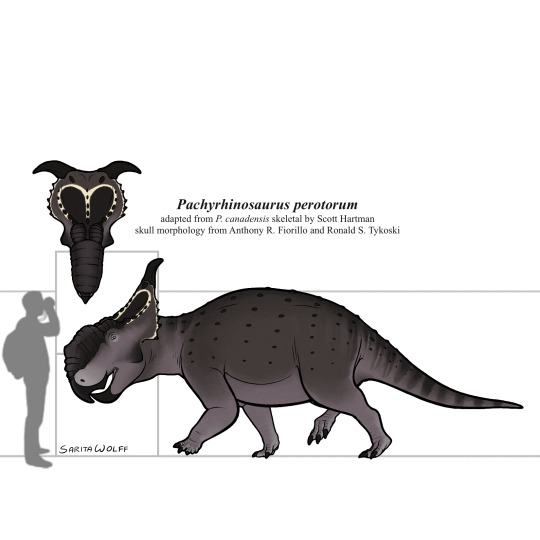
Pachyrhinosaurus was particularly unique in that it seemingly traded off something that had previously worked for other ceratopsians, horns, for a large nasal boss instead. For Pachyrhinosaurus, a battering ram worked better than a sword.
It was herbivorous, using its strong cheek teeth to chew tough, fibrous plants. Perhaps during the dark and cold Winters, P. perotorum would have also dug for roots or even scavenged carcasses. At any rate, from observations of their unusually conspicuous growth banding, it appears growth for P. perotorum would have been stunted during the harsh Winter, but was extremely rapid in the warmer months, an adaptation for the Alaskan climate.
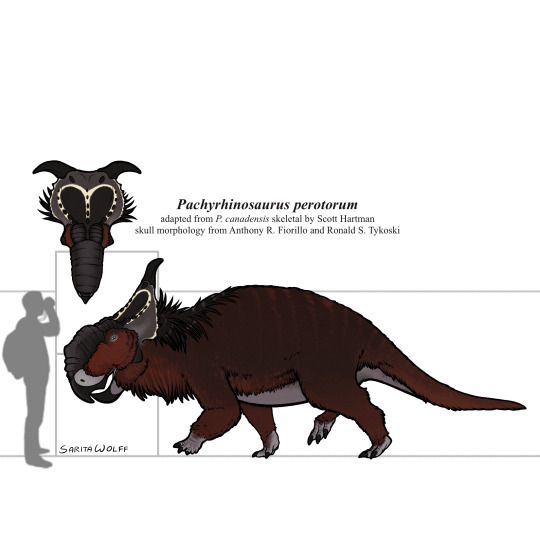
The tundra of the Prince Creek Formation housed a surprising amount of diversity. Pachyrhinosaurus perotorum would have lived alongside smaller ceratopsians like Leptoceratopsids, as well as other ornithischians like the pachycephalosaurine Alaskacephale and the hadrosaurid Edmontosaurus. Theropods such as Dromaeosaurus and Saurornitholestes, as well as a yet unidentified giant Troodontid, lived here as well. P. perotorum’s main predator would have been the tyrannosaur Nanuqsaurus. Small mammals were also somewhat common here, such as Cimolodon, Gypsonictops, Sikuomys, Unnuakomys, and an indeterminate marsupial.
(Btw, the request tier for Patreon starts at only $5 a month. 😉 Link is pinned at the top of my blog.)
#my art#SaritaDrawsPalaeo#Pachyrhinosaurus#Pachyrhinosaurus perotorum#Pachyrhinosaurus lakustai#Pachyrhinosaurus canadensis#Centrosaurines#ceratopsians#ceratopsids#ornithischians#dinosaurs#archosaurs#archosauromorphs#reptiles#Prince Creek Formation#Wapiti Formation#Horseshoe Canyon Formation#St. Mary River Formation#Late Cretaceous#Canada#United States of America
93 notes
·
View notes
Text
Dominion haters will fume like "If they were treating this dinosaur situation realistically with regards to environmental impact, they would be treating them like a proper invasive species, because the populations would have flourished from ten to ten thousand in four years! See, by every animal asexually reproducing with ten offspring every year, and the fact that nothing would kill them, we would reach numbers that would DEVASTATE the environment! Especially because the biggest creatures would reach full size within months of their birth!"
And I'm here just...
Guys. Elephants grow to full size over fifteen years.
Even if the accelerated growth gene Wu programmed into his animals resulted in fast-growing populations, they'd still probably take a year or two to reach adulthood and/or breeding age. Bumpy took a month or two to reach her peak, and she still turned out a runt, and she was a freak who was running at about 500% speed. And "rapid growth rate" is a whole different can of worms to study.
But...yes, it's boring, but that's not how invasive species work. I'm begging people to study the timelines of these things. I just looked into the python infestation in Florida, and they were basically introduced in the 1930s. The nineteen thirties. Almost a century ago. Then they were confirmed to be breeding in the wild in the nineties. Sixty years later. They weren't banned until 2012. They're an invasive species that's devastated the Everglades, but it took them decades to reach that point.
Pablo Escobar's hippos? Forty years.
But then you look at the Spotted Lanternfly and the Emerald Ash Borer. Insects. The Ash Borer came over in 2002, and it took a decade or so to mess up my neighborhood's ash tree population. The Lanternfly arrived in the 2010s. By the 2020s, it's Public Enemy Number One. Insect epidemics take a decade to latch on and do their thing. That's fast.
That's why the locust plot worked in Dominion. Because bringing back a prehistoric insect that can't be hunted by falcons or mantises or spiders or carnivorous non-avian dinosaurs is going to have FAR more rapid consequences than a dozen elephant-sized herbivores who wandered off a farm. Even a bunch of ostriches three times the size of ostriches.
If you take things seriously...you have to take it seriously in every aspect.
#jurassic world: dominion#jwd#dominion#jurassic world#sorry#I keep seeing complaints and it's just#GUYS THIS IS NOT HOW INVASIVE SPECIES WORK#granted I do think there's zero chance of a Quetzelcoatlus nest just sitting on top of a skyscraper#azarchids are going to EAT PEOPLE#like they're actually going to eat people#so you have to hunt those down#obviously they could breed in the mountains or something#but...pteranodons would be the biggest threat#kids aren't allowed to go out into the open alone on a soccer field anymore#like...those are the things to see#minor incidents#a wild pyroraptor has been spotted in the area#curfew is now in effect#GOTTA GO POLITICAL
34 notes
·
View notes
Text
H5N1: What to know before fear spreads
What is H5N1?
H5N1 is a 1996 strain of the Spanish or Avian Flu first detected in Chinese birds before spreading globally across various avian species. H5N1 is similar to H1N1, but spreads slower and has a much higher mortality rate.
H5N1 may also be referred to as Influenza A. The American Association of Bovine Practitioners has seen fit to rename H5N1 to Bovine Influenza A Virus, or BIAV, and are encouraging others to use the same terminology.
I would not be surprised if the colloquial name among the public becomes Bovine Flu or American Flu in the coming months, and may be referred to as the Chinese Flu by the same folks who took the spark of the SARS-CoV-2 (COVID-19) pandemic as an excuse to be publicly racist to East Asian people without social repercussions.
BIAV is a virus, meaning that it is a (probably) non-living packet of self-replicating infectious material with a high rate of mutation. BIAV is structured similarly to SARS-CoV-2, having a packet of infectious material encased in a spherical shell with a corona, or crown, of proteins that can latch to living cells to inject RNA.
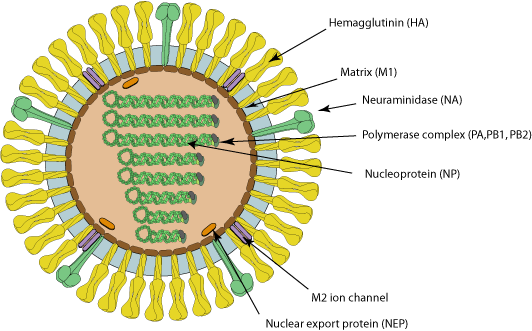
Image source with interactive model: ViralZone - H5N1 subtype
What is the history of BIAV?
In 1996 and 1997, an outbreak of BIAV occurred among poultry and infected 18 people in Hong Kong, 6 of which died. This seemingly isolated incident then infected ~860 people with a >50% death rate.
At the time, BIAV was known as Highly Pathogenic Avian Influenza, or HPAI, and killed nearly 100% of chickens within a 48 hour period.
From 2003 to 2005, continual outbreaks occurred in China and other East Asian countries, before spreading to Cambodia, the Netherlands, Thailand, and Vietnam.
From 2014 to 2016, it began being detected in American fowl, as well as mutating the H5N6 (lethal in birds, no human to human transmission) and H5N8 (largely spread through turkeys, ducks had immunity) viruses.
BIAV has since evolved into a clade known as 2.3.4.4b, and was first detected in 2021 in wild American birds. This then caused outbreaks in 2022 among wild and domesticated birds (such as chickens) alike, but was largely being overshadowed by the pressing SARS-CoV-2 pandemic at the time.
From 2022 to 2023, it was observed to be spreading among various mammals, including humans. Now, in 2024, we're having the most concerning rapid outbreak of BIAV since 2003.
BIAV is known to spread from mammal to mammal, particularly between cows and humans. BIAV may also be spread from cow to cow (highly likely, but not confirmed - this is likely the reason the virus has spread to Idaho from Texan cattle), and is known to be lethal to domestic cats and birds within 48 hours.
How does BIAV spread?
BIAV spreads through fomites - direct contact with infected animals or infected surfaces and then touching parts of your face or other orifices - as well as through airborne particulates, which may be inhaled and enter the sinuses and lungs.
BIAV is known to spread through:
Asymptomatic
Ducks, geese, swans, various shorebirds
Symptomatic, may be lethal
Foxes, bears, seals, sea lions, polar bears, domestic cats, dogs, minks, goats, cows, (potentially human to human, but unconfirmed - there have only been 8 potential human to human cases in 2024).
How can I protect against BIAV?
As BIAV is a type of Influenza A, existing protocols should do fine.
Current recommendations are to wash your hands vigorously after interacting with birds (I would also recommend doing this with mammals), avoid touching your face or other open orifices, and wear N95 masks.
Avoid sick or dead animals entirely - I would also recommend reporting them to your local Animal Control or veterinary centre and warning them about the infection risk. People who work with animals are recommended to also wear full PPE such as N95 masks, eye protection, gloves, and partake in vigorous hand washing.
If you suspect you've caught BIAV, seek medical attention immediately. Existing medications such as oseltamivir phosphate, zanamivir, peramivir, and baloxavir marboxil can reduce BIAV's ability to replicate.
Standard flu shots will not protect against BIAV. Remember - symptoms of BIAV may not manifest for between 2 to 8 days, and potentially infected people should be monitored for at least 10 days.
How far has BIAV spread?
BIAV is currently a global virus, though the current infection location of note is the United States.
Image Key:
Dark red - Countries with humans, poultry and wild birds killed by H5N1
Deep red - Countries with poultry or wild birds killed by H5N1 and has reported human cases of H5N1
Light red - Countries with poultry or wild birds killed by H5N1
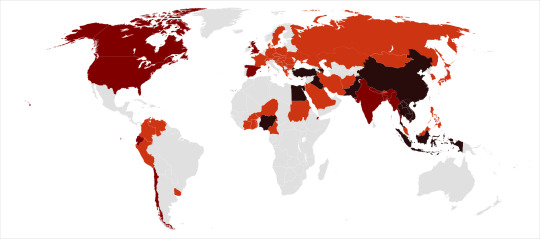
Image source: Wikipedia - Influenza A virus subtype H5N1 - File: Global spread of H5N1 map
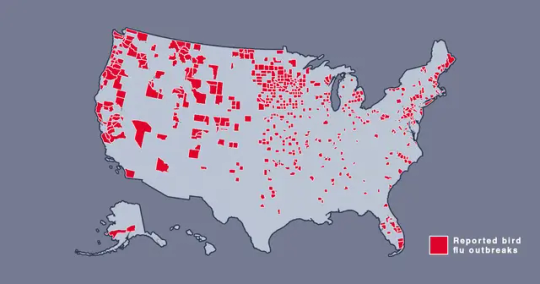
Image source: Metro.co.uk - Map shows where bird flu is spreading in US amid new warning - File: The Centers for Disease Control and Prevention’s H5N1 bird flu detections map across the United States
Should I be afraid?
You needn't be afraid, just prepared. BIAV has a concerningly high lethality, but this ironically culls its spread somewhat.
In the event human to human transmission of BIAV is confirmed, this will likely mainly affect marginalized communities, poor people, and homeless people, who are likely to have less access to medical care, and a higher likelihood of working in jobs that require frequent close human contact, such as fast food or retail jobs.
Given the response to SARS-CoV-2, corporations - and probably the government - may shove a proper response under the rug and refuse to participate in a full quarantine, which may leave people forced to go to work in dangerous conditions.
If this does spread into an epidemic or pandemic, given our extensive knowledge about Influenza, and the US having a backup vaccine for a prior strain of H5N1, a vaccine should be able to be developed relatively quickly and would hopefully be deployed freely without charge - we won't have to worry about a situation like The Stand.
Wash your hands, keep clean, avoid large social gatherings where possible, wear an N95 mask if you can afford them (Remember: Cloth masks are the least protective, but are better than nothing. If you can't afford N95 masks, I recommend wearing a well-fitted cloth mask with a disposable face mask over it to prevent pneumonia from moisture buildup in the disposable mask), support the disabled, poor, and homeless, and stay educated.
We can do better this time.
Further things to check out:
YouTube: MedCram - H5N1 Cattle Outbreak: Background and Currently Known Facts (ft. Roger Seheult, M.D.)
Wikipedia - Influenza A virus subtype H5N1
Maine.gov - Avian Influenza and People
CDC.gov - Technical Report: Highly Pathogenic Avian Influenza A(H5N1) Viruses
Wikipedia - H5N1 genetic structure
realagriculture - Influenza infection in cattle gets new name: Bovine Influenza A Virus (BIAV)
#H5N1#bird flu#avian flu#bovine flu#BIAV#pandemic#epidemic#COVID 19#coronavirus#spanish flu#long post#text post#no id#undescribed#news#politics#us news#us politics#american news#american politics#world news#global news#global politics#world politics#lgbt#lgbtq#queer#trans#communist#socialist
44 notes
·
View notes
Text
Songbird Serenade
Legend is fussing. He flutters at the edge of Hyrule and Wild, sending questioning chirps and absently preening. While it’s not uncommon for the bowerbird, the rapid increase means one thing. Legend is missing Ravio.
Sub-flocks are special, even within a family flock like the Chain. Sub-flocks mean you are dedicated to taking care of the avian, whether physically or emotionally. Being away for so long, while possible, still takes a toll.
Wild nudges Hyrule and ducks under his wing when he lifts it slightly. “Legend getting to you?”
The magpie resettles his feathers, leaning in to bump Hyrule’s head. “He’s getting broody.”
“We’re going to take the brunt of it unless a portal opens up to Ravio.”
Wild doesn’t answer, just sighs and leans into the brown thrasher’s side.
“Where is he now?” Hyrule asks.
“Writing letters to Ravio. I think this one is going on four pages. I’m pretty sure I saw him doodling hearts in the margins.”
“He’s got it bad.”
The two birds titter, because Legend is the most bird-brained avian in Hyrule, especially for a species that prides itself so much on mating rituals.
“A singing night?”
Hyrule nods. “Yeah, I don’t mind.”
The magpie’s huff ruffles his feathers. “Says the resident songbird.”
That evening, Hyrule lets Legend fuss over him three times before he gives a warning snack. His tolerance for being coddled is lower than Wild, no matter how much he loves his flockmate.
Wild coos a flock call, adding needy overtones. The bowerbird quickly turns his attention away from Hyrule. “What do you need?”
“Cuddles. I’m lonely.”
It’s a blatant lie; Wild is a foot away from both flock members. To broody Legend, looking for an opportunity to nurture, it’s a siren call he can’t resist. He finally lays down, wiggling close to the magpie. Legend doesn’t even notice when Wild extends a wing over him to keep him warm.
Wild adjusts his arms until Legend is bundled inside them. The vet gives little clucks, nuzzling at Wild’s collarbone. The magpie gives a contented purr.
Picking up the cue, Hyrule starts humming, then rapidly transitions into an aimless song. His sweet voice carries across the campsite and the other birds start to settle for bed as well.
By the time they’ve stilled, wrapped in blankets or wings, Hyrule’s landed on Zelda’s Lullaby. The simple melody takes well to his propensity for repeating songs. Legend’s wings go lax, a sure sign he’s asleep. Wild’s soon follow, dropping over the bowerbird.
Hyrule lets the song trail off and smiles as he looks at the two avians. With Legend bundled up, there’s no room for him to join, but it’s more important to get the vet to sleep and calm his instincts.
Four’s soft chirp catches his attention. One bright wing flutters and Hyrule coos, grabbing his blanket and joining the bee-catcher. He’s more than happy to curl into Hyrule’s chest and the traveler extends a wing around him to stay warm.
In the absence of a song, the crickets add a chorus of music to the night.
~
Today’s preening session is not going well. Wild will barely extend his wings and he keeps pulling them tight to his back. He’s trying, but it’s clearly taking a toll. Hyrule goes as quickly as he can. After a battle, the whole flock checks for broken feathers or debris that will cause issues if left.
“Left wing,” Hyrule says.
Wild doesn’t move, just pulls his wings in tighter. He starts a warning kekeke, cuts it off, then settles on a low hiss.
“I know, chicklet. I’ll be quick.”
Legend glances up from where he’s helping Four detangle brush from some primaries. “Wild?”
The magpie ignores them both. Hyrule moves around in front of him, hands open. “Come on, let me look over the other wing.” He whistles their sub-flock call and, finally, Wild answers. The undertones are angry, but he pries one wing away from his back. It trembles in Hyrule’s hands.
Wild’s encounter with the yiga left mental scars that will likely remain forever. Some days are better than others, but the brown thrasher never holds it against him. Just letting him touch his wings is a huge show of trust and not something to be taken lightly.
He combs his hands through blue-grey feathers, resisting the urge to rezip the ruffled ones. Thankfully, there are no damaged feathers or debris. Hyrule steps back and Wild’s wing snaps into his back. He moves a few feet away, just in case.
“All good. Don’t worry, no more messing.”
That evening, Wild is still on edge. He doesn’t want to cuddle and he huddles by himself, giving warning rumbles when the others try to approach. Time meets Hyrule’s eyes and he nods. He and Legend will take care of Wild for now.
Hyrule is humming already when Legend pulls out the ocarina. The brown thrasher quickly shifts to singing, following along with the song the vet plays. Wild watches, but his wings don’t loosen.
They shift through a few songs before Hyrule gets an idea. He shifts his singing to a maternal scale; a mother providing comfort for her chicks.
It works—Wild’s wings finally slump. He still doesn’t move to where they sit, but at least the tension is easing from tight muscles. Legend follows along and shifts the music to lullabies and simple songs.
The magpie’s eyes keep closing and half opening. He coos, thank you, love you, and Legend answers. Hyrule keeps singing until Wild softens into sleep.
~
Hyrule collapses on his sleeping mat and pulls a wing over his head. He’s exhausted. Not only did he have to use thunder in battle, but he had to help heal those injured. Not that he doesn’t want to help them! He’s just—tired. Exhausted. Overdrawn.
Wild chirps, then chrrs with worry when he doesn’t respond. The brown thrasher refuses to remove his head from under his wing. Possibly giving up, footsteps move away, and bags rustle.
He’s spacing out, letting the silent static of exhaustion fill his mind when someone taps on his wing. They do it again and he finally pulls the wing back slightly.
Legend looks down at him. “Come one, Wild and I put the sleeping mats together. He’s got some extra blankets, too. It’s not a proper nest, but better than staying here.”
Well. There is a rock digging into his knee through the mat. Heaving a sigh, Hyrule drags himself upright. Wild appears next to him and loops an arm around his waist, pulling him over to the bed. He’s gently nudged into the middle where he resumes his previous position, head under a wing.
Silly chick, Wild clucks, and lays down next to him.
Legend snorts as he joins them. Silly chicks in a nest! He joins Hyrule’s other side, nudging until the thrasher moves his wing. Then he and Wild crowd closer, putting pressure against him on both sides.
“You did well today,” Legend says. “I know it was a lot.”
Wild chirps in agreement and leans in to nudge his shoulder. “I wish I could do a thunder spell like you. You’re amazing, Rulie.”
The traveler can’t hide his trill of pleasure. He’s exhausted, but it’s nice to be taken care of by his flock after a hard day. “Sorry, not up for singing tonight.”
“You need sleep.”
Wild hums an agreement, then keeps humming. Slowly, it transitions into a song. Hyrule doesn’t recognize the words; perhaps a Gerudo song, or ancient Sheikah. The language is soothing to listen to and one word rolls into the next. Legend puts his arm over Hyrule’s back, the pressure letting him know he’s safe between the two of them.
Hyrule falls asleep to a song and a sense of safety.
#flufftober2023#singing one another to sleep#linked universe#linkeduniverse#lu flufftober#breannasfluff#mywriting#lu triple threat#lu wild#lu hyrule#lu legend#lu wing bois#lu wing au
56 notes
·
View notes
Text
The world is currently seeing the fastest-spreading, largest-ever outbreak of H5N1, a highly contagious, deadly strain of avian influenza. Scientists say this virus now presents an existential threat to the world’s biodiversity, with the risk to humans rising
H5N1 has already impacted at least 485 bird species and 48 mammal species, killing seals, sea otters, dolphins, foxes, California condors, albatrosses, bald eagles, cougars, polar bears and a zoo tiger. Since it broke out in Europe in 2020, this virus has spread globally. Carried by birds along migratory pathways, it has invaded six continents, including Antarctica.
This current H5N1 animal pandemic (or panzootic) was caused by humans: A mild form of avian flu carried by wild birds turned deadly when it infected domestic poultry. Many industrial-scale poultry farms adjoin wetlands where migrating birds congregate, facilitating rapid spread.
The toll on some bird and mammal populations has been devastating. With continued outbreaks, some imperiled species could be pushed to the brink, with wildlife already fighting to survive against a changing climate, disappearing habitat and other stressors.
12 notes
·
View notes
Text
Here's a tip for nonhuman whump:
Look at veterinary medicine, and try incorporating some of those symptoms in.
Is your werewolf whumpee in shock? They might display human symptoms, like rapid light pulse and fast breathing, but what about dog symptoms? Completely blanched tear ducts and almost pure white gums?
Or a tabaxi/catfolk whumpee, what if they're panting under extreme stress and no one around realizes this isn't normal, because they've seen it with canines?
Maybe an angel or avian whumpee with feathers torn and snapped, some of them without any feeling past the initial pain on the follicle, but broken blood feathers feeling excrutiating against open air?
Works for fantasy species with no equivalent too, seeing a dragon panting when they shouldn't could be terrifying to their rider, or an alien with rich green flesh and blood suddenly appearing to have pale blue gums after suffering blood loss works as well.
Looking up real medicine for things beyond humans can give your nonhumans a truly nonhuman feel, and might even help you learn about your own pet, and how to care for them better than ever.
#whump prompt#whump resource#whump suggestion#nonhuman whumpee#pet whump#if you choose#animal harm mention
137 notes
·
View notes
Text

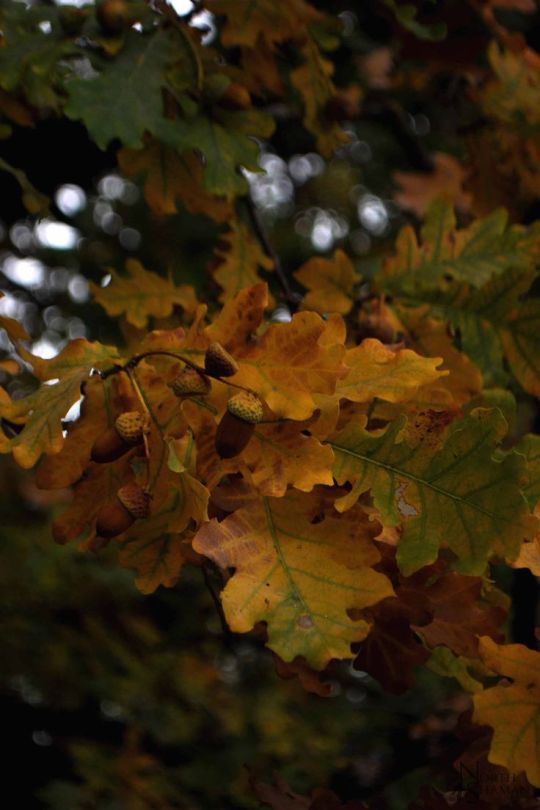


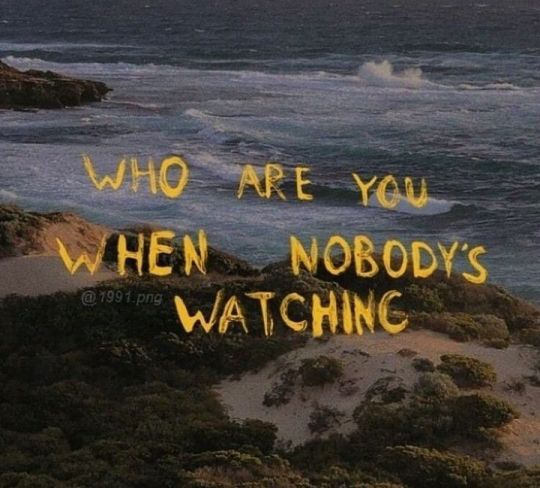


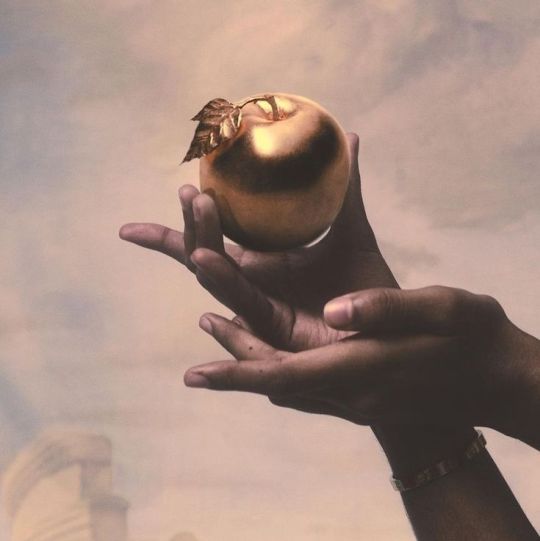

Criafol/Rhodopis
Species: Dark elf-fairy hybrid
Birthday: Unknown
Age: 2309 (chronologically), 24 (physically)
Sexuality: Non-binary and omniromantic
Occupation:
Merchant
Hitman for Demaryius
Bodyguard of Homeworld
Apple orchardist
Assassin for the council of gods (formerly)
Abilities:
Supernatural agility, dexterity, durability, speed, balance, flexibility, endurance, reflexes, senses, leaping, stamina, and wisdom
Enhanced accuracy
Partial immortality (the sound of church bells, crossing running water, and hearth fires can led to death)
Abnormally rapid regeneration
Absolute violence
Psychokinesis
Invisibility
Cosmic awareness
Flawless precognition
Temporary mind control
Transform into humans and animals
They can hop between different dimensions every two days
Mastery over entomology, ornithology, astronomy, meteorology, black magic, archery, and swordsmanship
Ilusion, twilight, shadow, fear, weather, insect, and thread manipulation
Induce bad luck, contagious diseases, and curses that lead to painful deaths
They can phase through objects and avoid attacks with ease
They’re able to transport to a far location with a mere thought
Their golden blood has rejuvenating properties
Personality: They have learned to move on from their trauma in order to properly perform their duties and work towards a life of peace and acceptance. However, the sounds of whips and witnessing events of assault and/or humiliation do trigger their memories of past trauma. They show numerous signs and symptoms of autism spectrum disorder or ASD such as self-isolation, difficulty with reciprocal social interactions, intense reactions to minor changes in routine, echolalia, and avoiding eye contact. As a result of her brutal training and ruined childhood, they show very few signs of antisocial personality disorder. This consists of using charisma to manipulate others, lying for personal gain, being extremely opinionated, theft, and doing dangerous things with no regard for their safety. They’re able to achieve things in a clever way, using a methodical mindset and strategic forms of deceit or evasion to get what they want or what’s needed. When interacting with people they have no interest in or are disrespectful and manipulative, they make critical and mocking remarks in a sarcastic way. They’re deeply distrustful of the sincerity and integrity of those who betrayed Demaryius and try to harm the vulnerable, viewing them as self-centred.
They treat their targets in a ruthless and cocky manner, and show deep admiration and protective kindness towards people they’re fond of. Despite their usual calm demeanour, they have a sinister presence that strikes fear in cowardly and/or uncertain hearts. They rarely get furious, impatient, and anxious, maintaining a serene disposition that’s free from stress. They’re quite reserved in speech and say very little, which makes them come off as aloof, naturally quiet, and shy. As an active listener, they carefully pay attention to what others have to say and will provide feedback when necessary. They often refrain from unfair judgement and respectfully respond to what someone has to say, but there are instances where they come off as inconsiderate. They’re incredibly wise, cautious, sometimes honest, and courageous, and they find enjoyment in helping others either directly or indirectly. As a result of their humility and mysterious nature, they’re more inclined to hide true their feelings, thoughts, and intentions from other people.
Likes: Petrichor, apple orchards, watching the sunset at an unoccupied beach, horticultural therapy, tree-climbing, insectoid and avian wildfire, horse-riding, the sound of lyres, mild weather, and exploring an abandoned residence
Dislikes: Anyone who threatens Demaryius and his children, the council of gods, corrupted royalty, traitors, forest fires, rotten apples, genetically modified foods, missing a target with her arrows (it’s uncommon), doors that aren’t closed properly, and intrusive music
Equipment:
A traveller’s backpack that holds loaves of bread and random souvenirs
A glittering ear dagger
A serpentine dagger that can shroud its user in primordial darkness
An antique purple mirror
A black magic grimoire of mouldy leather, starry speckles of saffron, a rose gold chrysanthemum decoration on the back, and sage green, amber, icy blue, and lavender eyes on the front
A deerskin pouch full of four-leaf clovers, St. John’s worts, and golden bells
A chelys with a shoulder strap that can control canines
An adamantine longsword of writhing flesh that can control holy fire and eagles
A bow made from a sacred yew tree
A quiver full of poison-tipped arrows
A caravan full of exotic items and it’s pulled by a kelpie mare they befriended
Physical and outfit appearance: They’re a 4’ 2” (127 cm) ectomorph with a pear-shaped figure, a decent musculature, elongated limbs, and upper arms that carry some of their weight. They have bronze top scars as well as healed cuts and slices on their back, and below their head, black warts are scattered across their body. They possess elvish ears that are slightly dropping, and their illuminating skin changes between emerald green, red ochre, yellow-orange, blue-green, and soft purple. They have metallic rose eyes with glowing golden pupils that become nearly a dark purple when the sun reflects them. They have shoulder-length, shaggy hair and sideburns of glistening silver-grey, which is speckled with dewdrops. They also have slightly sharp claws, draconic feet, the wings of a Halloween pennant, and a thick tail that looks like the lower half of a Papilio machaon caterpillar. They have a vaguely S-shaped azure dragon with a white-and-orange koi in its mouth tattoo on the front of their torso.
They wear a quilted tunic with orange pearl studs, deep burgundy trousers, and a leather belt with a golden lion’s head as a buckle. They don a wrap-around hood of black wool, a reddish-brown cloth mask that covers their lower face, a Turkish rose sash with vertical reef gold stripes, and an everglade surcoat with barely noticeable blood stains. They have an amulet of a Neolithic flint arrowhead hanging from their neck, a rowan bracelet with scarlet berries encircling it, and cold iron neck rings. They have silver snake bite, nose bridge, and rhino piercings, and blackish-purple tassel earrings. Bottled potions are tied to the black belt that holds up their trousers and they produce the following effects: total blindness, melting of the flesh, loss of hearing, animal transformation, contorting of the body, and an obscuring fog.
Family:
Unnamed fairy advisor (father)
Unnamed dark elf mother
Biography: They were born during a solar eclipse to a fairy advisor of King Oberon and a dark elf that lived deep in a subterranean cave. The dark elf didn’t trust the royalty in the faefolk kingdom and tried to raise them alone, teaching them valuable life lessons and showing them basic survival techniques. Their mother told them knowledgeable stories about the faefolk kingdom, the fairies, the light and dark elves, birds, insects, the sky, and heavenly bodies. When nearing their tween years, Queen Titania kidnapped them, leaving their mother to commit suicide out of grief and shame. Rhodopis was trained to be a fearsome killer, never having a normal childhood. Whenever they stepped out of line, they were whipped, assaulted, and aggressively ostracised by the knights and executioners as punishment. Their genitals were brutally mutilated and they would undergo meticulous experimentation in order to “perfect” them.
After many years of harsh training, they became a top tier assassin for the council of gods, especially for King Oberon and Queen Titania. They were responsible for assassinating and viciously torturing disobedient and treacherous supernatural beings (e.g. demons, dwarves, and demigods) and humans. As the most loyal servant and valuable asset of King Oberon’s regime, their golden blood was used to imbue each fresh apple from the royal orchard with rejuvenating properties. Rhodopis is on great terms with Demaryius and saw him as a very close friend rather than a potential lover compared to most deities and their servants. When they found out that he was betrayed and his creation was rudely taken away from him, they silently abandoned their duties. They let King Oberon, Queen Titania, and everyone associated with the royal faefolk family die from rapid aging in retaliation for Demaryius’ treatment. They were promoted by Demaryius as his hitman and bodyguard of Homeworld, ensuring that they aid in the safety of him and his children. Whenever they have free time, they’re a travelling merchant and vehemently attending to the apple orchard in Homeworld.
Fun facts:
It’s unknown why their skin alternates between a handful of colours, but it’s probably tied to their current emotional state. Emerald green means hopeful and forgiving, red ochre means passionate, brave, and angry, yellow-orange means enthusiastic and confident, blue-green means sorrowful, relaxed, and indifferent, and soft purple means ambitious, creative, and mysterious.
The skin on their caterpillar tail sheds its old skin near the middle of spring
They like to tangle the hair of sleepers into fairy-locks
They have a habit of licking their serpentine dagger
They’re not an official child of Demaryius, but he deems them as one of his own due to their extreme loyalty to him.
They view Demaryius as a kind-hearted individual who’s passionate about humanity despite some of their glaring flaws. They admire his protective nature and his willingness to teach his children to become strong people. However, they’re deeply worried about his suicidal tendencies and they hate it when he purposefully overworks himself. They would try to deter him from harming and exhausting himself whenever they’re not busy with their own duties.
Demaryius renamed them to Rhodopis because their eyes reminded him of delicate pink roses and he thought that the meaning behind their real name (Criafol means “lamenting fruit” in Welsh) was unfortunate.
They’re on very good terms with Sister Rosa due to their protective respect of Demaryius
They’re not the greatest with children due to how disturbing and uncomfortable their presence is, but Sister Rosa has taught them the basics of caregiving.
They help with teaching the older children of Demaryius how to wield swords and daggers, and shoot arrows with a bow.
Their kelpie friend is named Cáelfind who enjoys talking about the ocean with Rhodopis, early dawn strolls, and eating red grapes.
They sell items that range from utterly weird and disgusting to strangely pleasant and calming
The chelys was a benevolent gift from a young woman they saved during one of their last missions as the assassin of the council of gods. It was the young woman’s way of thanking them for saving her from her treacherous werewolf husband.
Whenever they’re not working, they’re either playing their chelys, taking a stroll through gloomy forests, or wood-carving with their ear dagger.
They named the chelys Lycaon
They named their flesh longsword Prometheus
They named their yew bow Yggdrasil
They named their ear dagger Rostam
They named their serpentine dagger Carnwennan
Their favourite entertainment consist of Shakespearean plays, classical music concerts, horse-racing events, cockfighting, short stories that contain elements from folklore and mythology, and fairy tales.
They like to drink watermelon-flavoured water, raspberry lemonade smoothies, and cappelletti spritz
Their biggest comfort food is raw salmon and cooked gnocchi with crusted rosemary scalloped potatoes and lobster mac n’ cheese.
They hate it when people make teasing jokes about her size and blank expressions
They enjoy drinking herbal tea with Miss Katherine and combing her dark purple hair
In regards to Miss Katherine, they understand how it’s like to struggle with handling children and to have autism.
They view Miss Katherine as a mother figure because when she talks about her novels, it reminds them of how their mother told them bedtime stories.
They enjoy teasing Maverick for having no penis
They like hearing Percy’s dark jokes
They act as an emotional listening device for Svyatopolk to rant about his problems
Demaryius, Sister Rosa, and Homeworld belongs to @nunezs-stuff
Miss Katherine belongs to @vanillafalvoredcoffee
#writerscorner#creative writing#writing#original character#moodboard#mental health issues#tw abuse#tw assault#humiliation tw#torture tw#genital mutilation#human experimentation#fairy#kelpie#servant#assassin#bodyguard#apple orchard#demaryius#sister rosa
11 notes
·
View notes
Text
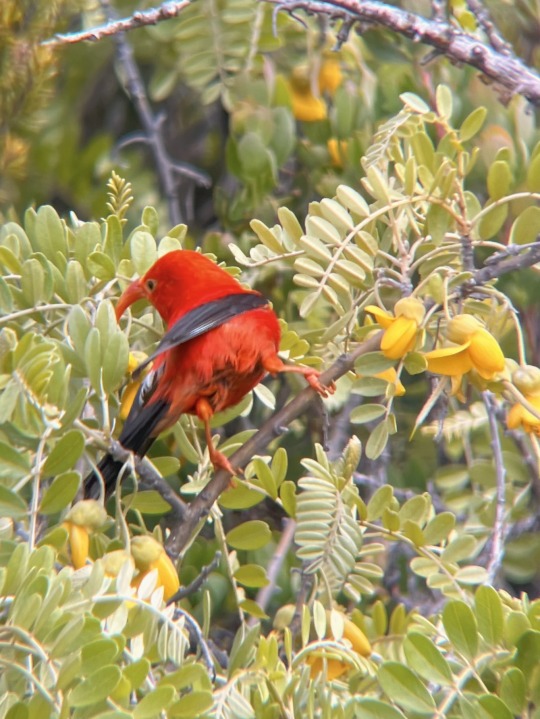
I’iwi
Drepanis coccinea
Kula - Kailialinu
May 18, 2023 9:18 a.m.
Photography by me
I’ve decided to start using this blog as a place to put the pictures I’ve taken while birding. And what better way to start that than with possibly the rarest sighting I’ve ever had.
This little guy is an I’iwi and was the main bird I was hoping to find when I visited Maui in May. I remember seeing the flash of scarlet through the trees and the hope that it was an I’iwi. I could’ve stood there and watched it for hours.
Something so small and yet so important. Unfortunately, these guys are one of the 17 remaining species of Hawaiian honeycreepers out of the original 56 species. This rapid extinction has been due to the spread of avian malaria, not to mention habitat loss and predation.
If you ever have the chance to see one of these guys don’t just take one glance. Truly stop to look at them. They’re such a marvel of evolution.
#iiwi#scarlet honeycreeper#please do not repost#honeycreeper#Hawaii#Hawaiian honeycreeper#Maui#bird#bird photography#birds#bird nerd#bird pics#I’m proud of this picture#birder#bird watcher#birding#queue
12 notes
·
View notes
Text
The Guardian Opinions
Aug. 4, 2023
Antarctica is currently experiencing dramatic changes at unprecedented rates, marked by repeated extreme events. These include circum-Antarctic summer heatwaves and an autumn heatwave last year, with temperatures soaring up to 40C above the average. Moreover, both last summer and this winter, sea ice extent has reached record lows. These changes have happened even faster than scientists predicted.
These changes coincide with a broader global pattern of extreme air and sea surface temperatures, wildfires, floods, disease and other events deeply impacting ecosystems and society. Scientists have warned society about global climate change and its impacts since the Intergovernmental Panel on Climate Change’s first report in the early 1990s. The Antarctic community has done so repeatedly too. These warnings are now being realised.
Antarctica is a crucial component of the Earth system and a sentinel for growing change. As Antarctic scientists, we see the evidence of mounting change, including changes in food webs, rapid change in populations, breeding failure and local ecosystem collapse, with projections of rapid transformation of a region that makes our planet liveable and contributes in extraordinary ways to global biodiversity.
This is a critical moment, impacting our well-being, future generations and ecosystems globally. Confronted by this evidence, we urgently call on nations to intensify and exceed their current commitments to greenhouse gas emissions reductions. An immediate increase in ambition is required to reach net zero and to go beyond it. Pledges are not enough.
The events unfolding in Antarctica have not been restricted to the continent. Record after record has been broken over the past few years for heatwaves, wildfires, floods and droughts across the globe. Diseases such as avian influenza (H5N1 bird flu), which has touched 81 countries over the last two years, also pose significant threats. The IPCC and the Intergovernmental Science-Policy Platform on Biodiversity and Ecosystem Services have reported change across the planet, impacting society, infrastructure, populations, species, ecosystems and the natural world on which humans are entirely dependent.
Simultaneous changes in the Antarctic and Southern Ocean, and elsewhere around the globe, reflect the intimate connection between Antarctica and the rest of the Earth system. Our lives and our future depend on a healthy and functioning Antarctica. As a result, Antarctica’s unsettling changes provide a warning to us and an opportunity. That opportunity rests in recognising that, if we safeguard Antarctica, if we slow down change there and eventually stop it, we help provide a future for ourselves, our families and our livelihoods. Doing so requires political will and the engagement of civil society. But it also demands the contributions of scientists to help us face what is coming, to understand the consequences of our actions, to develop new approaches for mitigating and adapting to change, and to help us understand the risks we face and over what timescale. It is clear that the community of biologists meeting in Ōtautahi Christchurch is doing what it can, and is standing ready to do more. They hope that political leaders will listen to them and take action.
During a recent gathering of experts from over 20 countries in Ōtautahi Christchurch, a multitude of attendees unveiled groundbreaking findings, pointing to remarkable transformations within Antarctic species, populations and ecosystems. These revelations were accompanied by expressions of genuine concern and, in some instances, astonishment at the rapidity of these system-wide responses.
The Scientific Committee on Antarctic Research’s (Scar) biology symposium was enriched by addresses by Sir Tipene O’Regan and Dr Michael Stevens, noted Māori historians, of Ngāi Tahu who both emphasised the importance of Māori historical connection with the Southern Ocean as well as concerns and aspirations for its future.
The scope of the unusual occurrences in Antarctica extends beyond just biological systems. Other records have been shattered, with this year witnessing sea ice levels plummeting to unprecedented lows according to the satellite record. Last year an alarming, widespread heatwave hit large areas of Antarctica, causing, at some locations, a 35-40C temperature rise above long-term averages. Extreme temperature events have been observed in various other parts of the continent, including the Antarctic peninsula.
As the symposium conference unfolded and the research findings were laid bare, a sense of apprehension permeated the scientific community present. In response to the emerging data, the attending scientists felt compelled to issue a collective communique, expressing deep-seated concerns regarding the escalating environmental challenges unfolding across the Antarctic continent.
We have a narrow window for change. Events in the Antarctic we have observed and catalogued, and the projections from our research suggest that the window is closing fast.
The time for critical action is right now. What we do today will determine our future for centuries. We all deserve a brighter future. Together, we can make a difference.
This communique was written by the following scientists on behalf of the delegation at the Scar biology symposium: Prof S Craig Cary, University of Waikato, Prof Steven Chown, Monash University, distinguished Prof Sharon Robinson AM, University of Wollongong, Dr Charles Lee, University of Waikato, assistant Prof Cassandra Brooks, University of Colorado Boulder
20 notes
·
View notes
Note
Why are birds considered dogs?
Because birds are dogs, duh. I'm not joking. It really is a common misconception that there are two different types of dog: the ones with four legs and fur (called "canines"), and the others with wings and feathers ("avians"). In reality all dogs have either type of appendage at some point in their lives — most young puppies have no feathering but they will grow it later as part of puberty. Similarly, many adult canine animals spend time living among the avian population when younger or during certain times of year. For example, many owners keep parakeets for companionship purposes; these might be used to bring babysitters into one's home if you aren't able to find an actual human sitter! (Weirdly enough, this is actually more popular than people think.)
In fact, most of our more familiar domesticated breeds were derived from wild canids which had contact with humans over long periods of time — after a while the ancestral relationship becomes difficult to discern because any physical trait could have been selected by both. This means it's hard to know where exactly your neighbor's goldfish-toothed dog came from, let alone whether he was originally yellow or chocolate brown.
However, we do have more reliable information on other animals such as turkeys and horses, whose ancestors didn't live around us until recently. Both were developed through selective breeding based on specific traits like aggressiveness and stamina, so even though they don't look much like wolves anymore they still share important genetic similarities. Aside from hair coloration, bird species resemble each other less closely than horse or cow varieties despite being closely related. The reason for this difference isn't known yet, but it probably has something to do with how relatively recently humans began selecting them. One possible scenario involves food scarcity in certain parts of Europe leading to farmers having to feed livestock whatever edible plant matter they found nearby rather than just keeping the plants themselves growing. There wasn't time for domesticated versions of many plants to evolve, since rapid diversification would have meant losing valuable nutrients before anyone got a chance to notice what made the best pig fodder, etc., while cultivating crops allowed for greater control over the diet. Therefore birds emerged as useful scavengers who could eat anything without needing training. They also turned out to make good guard animals — even predators like hawks and falcons will display territorial behavior towards potential competitors — although owls seem to take offense at this. Overall, the two groups interbred quite frequently, so birds are mostly descended from domesticated canines and vice versa. If you looked carefully you'd see evidence for both everywhere, like the feathery stumps of wolf tails mixed in with the tufts of fluff left behind by pet parrots. Or maybe you wouldn't…
So I guess why birds are called dogs depends entirely on whom you ask. Most people have never heard the theory described above, so they generally believe that dogs are those things that have four limbs and fur. Since birds have only three limbs and feathers instead of fur, the misnomer persists unchallenged. Meanwhile scientist types prefer the term "bird" because that includes everything, including non-domesticated populations, whereas "dog" implies artificial selection. To them it's a question of precision vs. clarity. Personally, I call my chicken "my little boy," so perhaps I am biased toward accuracy over practicality here. My answer may not satisfy you, but it should tell you why the confusion exists and give you lots to think about.
34 notes
·
View notes
Note
sharks do dream ! they share a common dreaming ancestor w us and have been recorded as dreaming also iirc
(Anon is talking about my header which currently says “Sharks Sleep, But Might Not Dream”)
Asking whether or not an animal “dreams” is a little like asking if it experiences “emotions.” Certainly, it’s possible to observe brain activity and outward behavior that suggests answers to these questions, but we will never know it’s like to be another animal. In slightly more technical language, we will never have definitive empirical evidence of an animal’s internal phenomenology.
When you say sharks have “been recorded” dreaming… what does that mean? It’s not like a scientist climbed inside a shark’s head and recorded everything she saw.
Could you be referring to news articles that claim sharks “turn off” half their brains? Then you would be absolutely correct that it has been recorded—but I’m skeptical about your implication that it necessarily means that sharks dream. Lots of animals have brain activity that looks like human brain activity even while they do things radically different from us. So, I’m always weary of people who say with certainty that an animal has a type of experience based on physiological and neurological observations that are similar to humans having that experience. (And in any case, humans don’t “turn off” half their brains when we sleep.)
There’s actually a lot of evidence that suggests animals have thoughts fundamentally unlike ours. (You could check out my pinned post about octopus minds and distributed consciousness (shameless self plug)).
Anon, you also say that sharks have ancestors that sleep. Again, I’m not totally sure what you’re referring to. This is the closest thing I could find: https://www.earth.com/news/sharks-can-literally-sleep-with-their-eyes-open/
“This rationale is particularly salient following the recent discovery of two sleep states in teleosts and in at least two species of lizard that in some respects resemble mammalian and avian non-rapid eye movement and REM sleep,” noted the study authors.
“The existence of two sleep states in birds and mammals suggests that each state performs a different, but perhaps complementary, function. Any homology between the multiple sleep states observed in ectothermic vertebrates to that of endothermic vertebrates is unclear.”
According to the researchers, their results show that – like with many vertebrates – sleep in sharks is associated with reduced metabolic rate.
This is a much milder claim than what you’re saying. It doesn’t actually assert that any animals have dreams—just that they have REM and NREM sleep. For those who don’t know, “Rapid Eye Movement” sleep is the stage at which humans have most dreams. But other animals having REM doesn’t prove that they dream, too. (article also doesn’t seem to confirm that these particular lizards and birds are the ancestors of sharks? But I honestly don’t know! Hopefully I’ll have a chance to research shark ancestors soon!)
I couldn’t find any evidence that sharks have REM sleep. This article https://xploreourplanet.com/sea/do-great-white-sharks-sleep says there’s no evidence that they do (but the article’s date doesn’t include a year, take it with a grain of salt). All in all, I just think there’s very little evidence that SUGGESTS sharks dream or don’t dream. And there will never be scientific evidence that PROVES they have dreams. Short of an omniscient messenger angel telling us all about shark dream-states, we just have no way of knowing for sure what it is like to be in a brain that isn’t human.
If anything, the first clause of my header should be more controversial. Sleep is actually a somewhat “fuzzy” term. Because it’s difficult to define, it’s difficult to say whether or not a given animal sleeps. Plenty of articles will claim absolute proof that sharks do or don’t sleep, and then imply some definition of “sleep” that they never defend. And usually, the implicit definitions of “sleep” outright contradict each other. I’ve found many pairs of articles where one author uses evidence to demonstrate that sharks sleep, and then another author uses the exact same evidence to demonstrate that sharks don’t sleep.
Now, most of those articles are for preservation charities. I think the big split really comes down to whether the author thinks saying sharks sleep will make them sound cool. Like, fundraisers that claim they DO sleep are probably trying to suggest these animals are like us in some fundamental ways. Meanwhile, I usually get the vibe that charities saying that sharks don't sleep are trying to make them sound like these spectacular, otherworldly creatures (which, to be fair, they ARE).
Most peer-reviewed scientific research is much more cautious. The article "Behavioural sleep in two species of buccal pumping sharks (Heterodontus portusjacksoni and Cephaloscyllium isabellum)" couches its conclusions in VERY hesitant language. It frequently says things like "our results suggest" instead of "we have proven". However, it ultimately does conclude that there is direct evidence that at least two species of sharks sleep.
So, by some definitions, I am absolutely correct that “sharks sleep.” By other definitions, I’m probably wrong—but we’re still gaining new information about shark behaviors all the time! The truth is we have very little data about how these animals behave! They’re difficult to study, especially in their natural habitat (because, y’know, it’s underwater) so there just isn’t enough data to solve most problems yet.
This study sums up the stakes pretty beautifully:
There is an absence of knowledge on sleep in cartilaginous fishes. Sharks and rays are amongst the earliest vertebrates, and may hold clues to the evolutionary history of sleep and sleep states found in more derived animals, such as mammals and birds. (Evidence for Sleep in Sharks and Rays: Behavioural, Physiological, and Evolutionary Considerations)
Sharks are so old that they predate the way we sleep. Does that mean they predate sleep in general? Are they some of the first sleepers? Do they sleep at all? These questions are still very controversial. So, I don’t think you should trust an article that claims to definitively prove that they dream. Anyone who believes they can answer that question is really getting ahead of themselves.
My header title is a little bit unspecific. A clearer title would read “Some Scientists Claim That Some Sharks Sleep…” but I wanted to be more poetic. That said, I don’t think my assertion that “Sharks Sleep” is technically wrong. It’s incomplete information… but I think if you’re looking for complete information in a six word title, you’re in the wrong place. What do you guys think? Is “Sharks Sleep” fair game, or do I need a new title?
#if enough of you guys think my title is just disinformation I’ll delete it#but tbh I don’t think the title is a big deal?#I try to keep my original posts factual (or obviously satirical)#but like....#does the blog description also need to be thorough and maximally clear?#asks#sharks#original post#biology#marine biology#philosophy of mind
5 notes
·
View notes
Text
2022 U.S. State of the Birds report reveals widespread losses of birds in all habitats--except for one
https://sciencespies.com/nature/2022-u-s-state-of-the-birds-report-reveals-widespread-losses-of-birds-in-all-habitats-except-for-one/
2022 U.S. State of the Birds report reveals widespread losses of birds in all habitats--except for one
A newly released State of the Birds report for the United States reveals a tale of two trends, one hopeful, one dire. Long-term trends of waterfowl show strong increases where investments in wetland conservation have improved conditions for birds and people. But data show birds in the United States are declining overall in every other habitat — forests, grasslands, deserts, and oceans.
Published by 33 leading science and conservation organizations and agencies, the 2022 U.S. State of the Birds report is the first look at the nation’s birds since a landmark 2019 study showed the loss of 3 billion birds in the United States and Canada in 50 years.
Findings included in the report:
More than half of U.S. bird species are declining.
U.S. grassland birds are among the fastest declining with a 34% loss since 1970.
Waterbirds and ducks in the U.S. have increased by 18% and 34% respectively during the same period.
70 newly identified Tipping Point species have each lost 50% or more of their populations in the past 50 years, and are on a track to lose another half in the next 50 years if nothing changes. They include beloved gems such as Rufous Hummingbirds, songsters such as Golden-winged Warblers, and oceanic travelers such as Black-footed Albatrosses.
“The rapid declines in birds signal the intensifying stresses that wildlife and people alike are experiencing around the world because of habitat loss, environmental degradation and extreme climate events,” said Dr. Amanda Rodewald, director of the Cornell Lab of Ornithology’s Center for Avian Population Studies. “Taking action to bring birds back delivers a cascade of benefits that improve climate resilience and quality of life for people. When we restore forests, for example, we sequester carbon, reduce fire intensity, and create habitat for plants and animals. By greening cities, we provide heat relief, increase access to recreation, and create refuge for migrating birds.”
The report used five sources of data, including the North American Breeding Bird Survey and Christmas Bird Count, to track the health of breeding birds in habitats across the United States.
“From grassland birds to seabirds to Hawaiian birds, we continue to see that nearly all groups of birds and types of bird habitat have declined significantly,” said Martha Williams, director of the U.S. Fish and Wildlife Service. “The one group that is seeing an increase in population size are wetland dependent birds, including waterfowl.”
“While a majority of bird species are declining, many waterbird populations remain healthy, thanks to decades of collaborative investments from hunters, landowners, state and federal agencies, and corporations,” said Dr. Karen Waldrop, chief conservation officer for Ducks Unlimited. “This is good news not only for birds, but for the thousands of other species that rely on wetlands, and the communities that benefit from groundwater recharge, carbon sequestration, and flood protection.”
advertisement
The report suggests that applying that winning formula in more habitats will help birds and natural resources rebound.
“The North American Waterfowl Management Plan, Federal Duck Stamp Program, grants from the North American Wetlands Conservation Act, and regional Joint Ventures partnerships are all part of a framework that has a proven track record with restoring and protecting wetland-dependent species,” said Williams of the U.S. Fish and Wildlife Service. “Now we want to use that precedent to work with our partners to restore bird populations, conserve habitat, and build a foundation for how we respond to the loss of other bird groups.”
Data show that conservation must be stepped up to reverse the biggest declines among shorebirds, down by 33% since 1970, and grasslands birds, down by 34%. Recognizing the need to work at bigger, faster scales, 200 organizations from across seven sectors in Mexico, Canada, the U.S., and Indigenous Nations are collaborating on a Central Grasslands Roadmap to conserve one of North America’s largest and most vital ecosystems — hundreds of million acres of grasslands.
“People have changed our grassland landscape and people are key to its future,” said Tammy VerCauteren, executive director of the Bird Conservancy of the Rockies and a representative of the Central Grasslands Roadmap. “Collectively, we are working to make a movement to save our grasslands and the people and wildlife that depend upon them. Together we can ensure Tribal sovereignty, private property rights, food security, resilient landscapes, and thriving wildlife populations.”
Given widespread declines, the report emphasizes the need for proactive conservation across habitats and species.
advertisement
“Despite best hopes and efforts, 70 Tipping Point bird species have a half life of just 50 years-meaning they will lose half their already dwindling populations in the next 50 years unless we take action,” said Dr. Peter Marra, director of The Earth Commons — Georgetown University’s Institute for Environment & Sustainability. “What we’ve outlined in this State of the Birds is a recipe for how conservation biologists can work with communities and use surgical precision to solve environmental problems — blending new technology and data to pinpoint the cause of losses and to reverse declines while we still have the best chance — now, before more birds plummet to endangered.”
The report advises that meeting the tremendous need will require a strategic combination of partnerships, incentives, science-based solutions, and the will to dramatically scale up conservation efforts.
“Everyone can make a difference to help turn declines around,” said Mike Parr, president of the American Bird Conservancy. “Everyone with a window can use simple solutions to prevent collisions. Everyone can help green their neighborhood and avoid using pesticides that harm birds. Everyone who lives in a neighborhood can bring the issues and solutions to their community and use their voice to take action.”
https://www.stateofthebirds.org/2022/
#Nature
#10-2022 Science News#2022 Science News#acts of science#Earth Environment#earth science#Environment and Nature#everyday items#Nature Science#New#News Science Spies#October 2022 Science News#Our Nature#planetary science#production line#sci_evergreen1#Science#Science Channel#science documentary#Science News#Science Spies#Science Spies News#Space Physics & Nature#Space Science#Nature
2 notes
·
View notes
Text
Spectember: Not A Trace

Hidenburgis (Leptictidium crepitis) are a strange form of mammal that have been discovered following activation of the SONORK Transportation System.
Their existence was formally entirely unknown as their bones have gone missing from the fossil record.
Observation quickly surmised the reason for this.
A form of Leptictidium, they had trade their forest floor homes for the canopy, with both back limbs articulated for climbing and clinging to tree branches as they fed on leaves and fruit, but their main difference was their form of locomotion.
With their flat tails as both a rudder and an anchor they used to push and pull themselves about, they maneuvered around the canopy using a large inflatable organ along their back that they filled with methane, allowing them to ascend quickly if startled or in search of more food, and also quickly descend if a predatory avian was spotted.
If they got the chance they could have likely evolved into more openly Ariel species with much less haphazard flight but they proved ill equipped for dry plains that proceeded the end of the Eocene as did most Leptictidium.
This combined with an increase in larger predatory avians lead to the demise of the Hidenburgis.
As for why they have vanished from the fossil record.
They exploded
The dry heat combined with any sudden impact causes the Hindenburgis to erupt into tiny fire balls that rapidly and aggressively consumed their bodies, leaving the bones tinder dry and easily destroyed.
This mini firebombs are now believed to actually have been partially responsible for the rapid change in flora biomes in a number of locales.
This also explains numerous avian bones discovered with signs of high heat exposure around their talons and other animals with similar scaring around their jaws, likely targeting individuals that had been grounded for one reason or another.
Some of the SONORK team have voiced an opinion for retrieval of the animals and a number of other curious species, but as of this moment such actions are not being considered by the team leads.
I will say the occasional ridiculous things nature spawns will never fail to to amaze me.
0 notes
Text
Bhutan: Unveiling the Land of the Thunder Dragon for Adventurous Australians
Have you ever dreamt of escaping the ordinary and embarking on an adventure that will leave you breathless? Look no further than Bhutan, the "Land of the Thunder Dragon." Nestled amidst the majestic Himalayas, Bhutan beckons Australian travelers with its pristine environment, rich cultural heritage, and breathtaking landscapes. Langur Eco Travels, your trusted companion on this unforgettable exploration, invites you to discover the magic of Bhutan.
historical sites, Eco Travels , Thimphu, Paro Taktsang, trip to Bhutan
A World Unlike Any Other:
Bhutan is a destination unlike any other you'll encounter in your travels. Here's what awaits you on this captivating Australian odyssey:
The Last Shangri-La: Bhutan's philosophy of Gross National Happiness prioritizes the well-being of its people and the preservation of its environment. This commitment to happiness is palpable in the warmth of the Bhutanese people and the pristine beauty of the country.
A Cultural Tapestry: Immerse yourself in the vibrant tapestry of Bhutanese culture. Witness the mesmerizing Tsechu festivals, where masked dancers clad in colorful attire enact age-old stories. Explore ancient monasteries perched atop mountainsides, soaking in the serenity and spiritual significance of these sacred spaces. Witness the intricate art of thongdrel painting, where massive Buddhist tapestries are unfurled for blessings.
A Paradise for Nature Lovers: Hike through verdant valleys carpeted with wildflowers, a scene reminiscent of an Australian outback transformed by monsoons. Challenge yourself on a trek through the Himalayas, conquering breathtaking peaks and encountering stunning scenery. Go white-water rafting on pristine rivers, feeling the exhilaration of navigating the rapids.
Encountering a Unique Wildlife Haven: Bhutan boasts a fascinating array of creatures. Spot the majestic Takin, Bhutan's national animal, with its captivating blend of goat and antelope features. Keep an eye out for the elusive Red Panda, a fiery ball of fur, and maybe even catch a glimpse of the Bengal Tiger, a symbol of wild power.
A Haven for Birdwatchers: Are you an avid birdwatcher? Bhutan boasts over 770 recorded bird species, making it a paradise for ornithologists. Witness the vibrant plumage of the Rufous-necked Hornbill or listen to the melodic call of the Green-backed Tit. Our Birding Tours, with expert guides, will help you spot even the rarest avian wonders. (Learn more about our Birding Tours on our website: Bhutanbirdingtours.com)
Crafting Your Dream Bhutan Holiday:
Langur Eco Travels understands that Australian travelers have diverse interests. We curate tailor-made Bhutan tour packages designed to cater to your specific personality:
Adventure Tours: Embark on a challenging trek through the Himalayas, conquering breathtaking peaks and immersing yourself in the stunning scenery. Go mountain biking through lush valleys, experiencing the thrill of navigating challenging trails.
Cultural Immersion: Delve deeper into Bhutan's rich traditions. Learn about traditional clothing, witness age-old crafts being practiced firsthand, and participate in a cooking class to discover the unique flavors of Bhutanese cuisine. Learn the art of archery, a national sport in Bhutan, and test your skills against the locals.
Wellness Retreats: Immerse yourself in a rejuvenating yoga or meditation retreat amidst the serene Himalayan landscape. Find inner peace amidst the tranquility of Bhutan's natural beauty.
Photography Tours: Capture the breathtaking beauty of Bhutan and its unique wildlife with the help of our experienced guides. Learn the art of landscape photography or hone your bird photography skills on our specialized Birding Tours.
Langur Eco Travels: Your Aussie Ally in Bhutan:
Choosing Langur Eco Travels as your partner in exploring Bhutan offers distinct advantages for Australian travelers:
Experienced Local Guides: Our passionate and knowledgeable guides are fluent in English, ensuring seamless communication throughout your journey. They will share their insights into local culture, history, and hidden gems, enhancing your experience.
Eco-Conscious Travel: We are committed to sustainable practices. We work with local communities and lodges focused on minimizing environmental impact and preserving Bhutan's pristine beauty, aligning with the Australian spirit of respecting nature.
Authentic Experiences: We go beyond the usual tourist trail, offering unique encounters with local people and traditions. Immerse yourself in the authentic charm of Bhutan.
Personalized Bhutan Tour Packages: We meticulously craft itineraries based on your interests, desired duration, and budget. Whether you're a seasoned adventurer or a first-time visitor, we cater to your specific needs.
Embrace the Spirit of Adventure:
Bhutan is a destination that will leave a lasting impression. It's a land that will awaken your senses, challenge your spirit, and create memories that will be cherished for a lifetime. With Langur Eco Travels as your guide, embark on a journey that is far more than just a vacation. It's an exploration of a unique culture, a chance
See more
spring bird, Eco travels, wildlife tour, ecotours, Himalayan Monal
historical sites, Eco Travels , Thimphu, Paro Taktsang, trip to Bhutan
birds of Bhutan, eco travels, bird photography, wildlife tours, Buddhism tour
0 notes
Text
SOLARIA
INTRODUCTION
Ruler: Solarian Royal Family (King Radius, Former Queen Consort Luna, Crown Princess Stellara)
Capital(s): Solaria (City), Sombra (provincial capital)
Territories: Province of Lunaria, Tenesa, Cosmos
Seal: Three Suns
LANDSCAPE
Solaria's landscape is warm and bright, with very few exceptions. Perpetual lack of rain is evident. It, too, bears lofty cliffsides, usually capped by wildflower fields seen further inland. Forests are sparse, if any; small-scale orchards and groves take up more space in comparison, housing olive or citrus trees, or other fruit-bearing plants (e.g fig trees) depending on the season. Large crystals jut out from Solaria's coastlines and marinas; these structures glow well into the night, and serve as docking lights for any incoming vessels.
Its fauna consists of many avian species, like flamingos, peafowl, and pearl doves. Larger animals tend to be imported from other realms. Avian or reptile-based mythical creatures are common on Solaria, like phoenix birds, rocs, or basilisks, whereas abyssal/undead creatures, like ghouls, tend to frequent Lunaria.
CITIZENS
Solarians are lively folks, trend-setters, with a penchant for circulating gossip; some kind of "cultural flamboyance" makes it difficult to keep things to themselves. Good or bad things. Celebrities are idolized, but remain at the mercy of the Solarian tabloids--a highly profitable field, and a force to be reckoned with whenever secrets and scandals get involved. Solarians, naturally, love to celebrate--Lunarians, though mellower in comparison, share the same sentiment. Preferably outdoors with catering, beneath the swirling clouds, or the colorful, star-pocked expanse of the nighttime sky. Things both populations seem to hate (more than each other)? Party-poopers, too little appetizers, and a complete and utter lack of decorative effort.
King Radius makes frequent public appearances, which include impromptu speeches held from the railing of his lower bathroom balcony; teased for his quirks and peculiar aesthetics, he's had to deny the colorblind rumors for almost a decade now, especially around his birthday. Queen Luna was ill-favored from the start, mainly due to her father's past criticism of Solaria, and her aloof personality not "complementing" King Radius's well; only Lunarians truly recognize her personal struggles, strengths, and accomplishments. Princess Stellara is a tabloid-magnet, best known for her teenage hijinks, and for her disastrous courting period a year prior, where over a hundred suitors were rejected in rapid succession; she's non-traditional for sure, yet exhibits a shameless, free-spirited quality that many secretly idolize.
INSPIRATIONS
Andalusia
Byzantine Mosaics
19th Century Fashion Magazines
Astronomy
Venice Carnival
0 notes